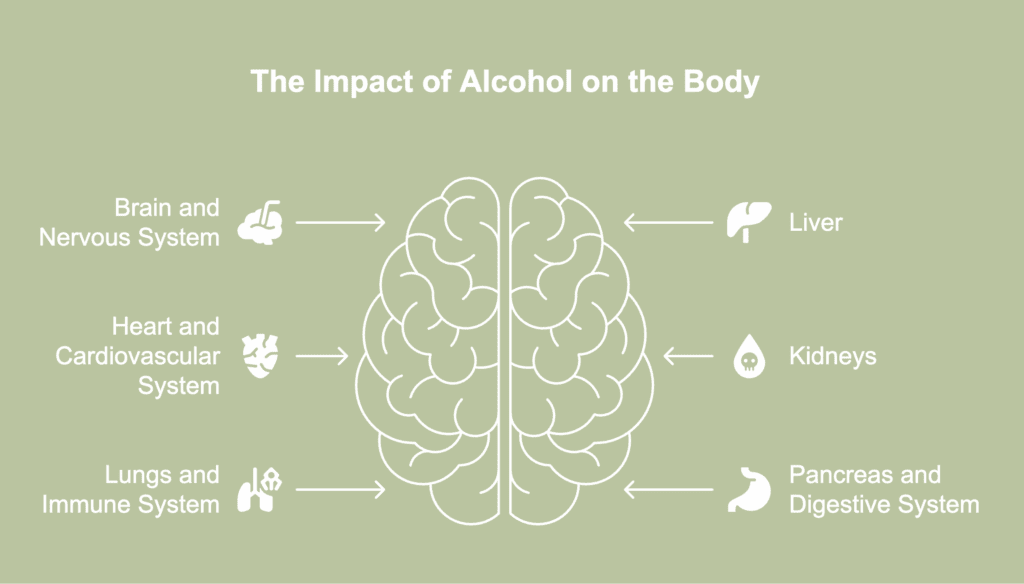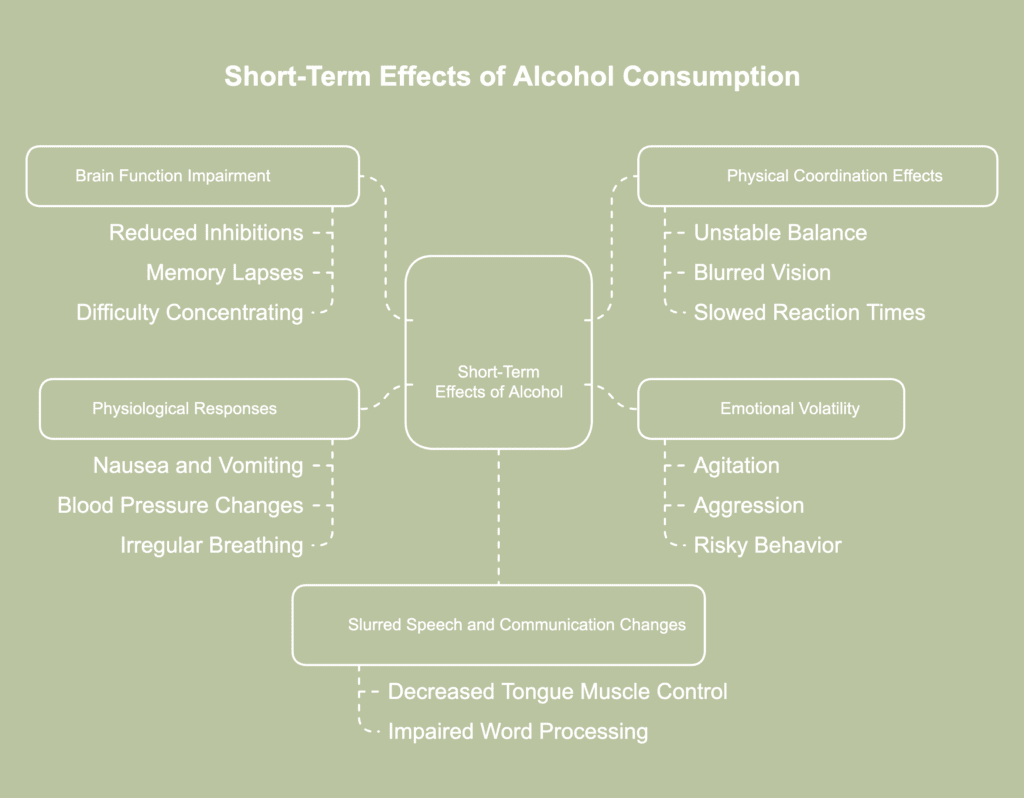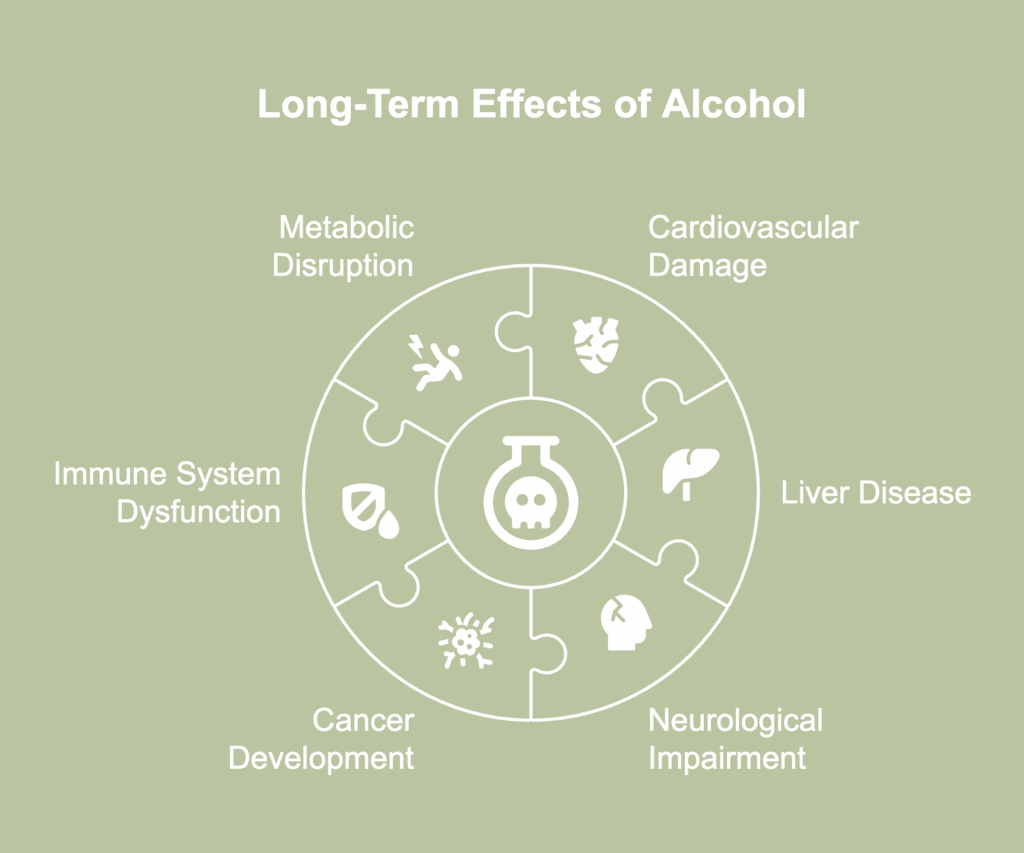Effects of alcohol: short-term, long-term, physical, and psychological

The effects of alcohol are complex physiological and psychological changes that occur in the human body during and after alcohol consumption, ranging from immediate impacts on brain function and behavior to long-term health consequences affecting multiple organ systems.
The short-term effects of alcohol include brain function impairment, physical coordination effects, slurred speech and communication changes, emotional volatility, and physiological responses.
The long-term effects of alcohol are cardiovascular damage, liver disease, neurological impairment, cancer development, immune system dysfunction, and metabolic disruption.
The physical effects of alcohol include cardiovascular system effects, neurological impacts, liver damage, digestive system disruption, immune system suppression, vision and balance impairment, and dehydration.
The psychological effects of alcohol are cognitive impairment, emotional dysregulation, behavioral disinhibition, mental health impact, and addiction.
What happens when you drink alcohol?
When you drink alcohol, the chemical compound ethanol enters the bloodstream through the digestive system (stomach and small intestine) and travels throughout the body, affecting multiple organ systems: brain function, liver processing, heart rate, and behavioral responses.
Alcohol (ethanol, C2H5OH) acts as a central nervous system depressant altering neurotransmitter function in the brain. Alcohol absorption begins immediately in the mouth and continues through the stomach lining. The small intestine absorbs 80% of consumed alcohol into the bloodstream. Blood vessels dilate, causing warmth and flushing of the skin.
The liver metabolizes alcohol at a fixed rate of approximately one standard drink per hour. Alcohol dehydrogenase enzymes in the liver convert alcohol into acetaldehyde, a toxic compound. The rate of metabolism remains unchanged despite consuming food, water, or caffeine.
The brain experiences reduced activity in critical regions controlling judgment, speech, and motor skills. Alcohol binds to gamma-aminobutyric acid (GABA) receptors, causing sedation and decreased anxiety. Dopamine release increases, creating temporary feelings of pleasure and reward.
Blood alcohol concentration rises based on multiple factors: body weight, biological sex, food consumption, and drink strength. An article titled “What Is A Standard Drink?” updated in December 2024 by the National Institute on Alcohol Abuse and Alcoholism defines a standard drink as 14 grams, or around 16 ounces, of pure alcohol.
The heart rate increases while blood vessels dilate. Blood pressure temporarily rises then falls below normal levels. The kidneys produce more urine through alcohol’s interference with antidiuretic hormone production.
Which organs does alcohol affect?

Alcohol affects multiple vital organs throughout the body, primarily impacting the brain, liver, heart, kidneys, and lungs. The organs primarily affected by alcohol are listed below.
- Brain and nervous system: Alcohol interferes with brain communication pathways and alters cognitive function. Unhealthy alcohol use suppresses the central nervous system, causing immediate effects like slurred speech, impaired coordination, and memory problems.
- Liver: The liver metabolizes alcohol and sustains direct damage from processing toxins. The liver’s ability to filter toxins decreases with sustained alcohol use. Over time, excessive drinking leads to inflammation, fatty liver, and scarring, increasing the risk of liver disease.
- Heart and cardiovascular system: The heart muscle stretches and weakens due to alcohol, resulting in cardiomyopathy. Blood vessel dilation from alcohol affects circulation throughout the body.
- Kidneys: Alcohol causes direct and indirect damage to kidney function through dehydration and blood pressure changes. Binge drinking particularly stresses kidney function.
- Lungs and immune system: The epithelial barrier in the lungs is damaged by alcohol, leading to inflammation and decreased protection against infections. The immune system becomes compromised as alcohol makes white blood cells less efficient at fighting disease.
- Pancreas and digestive system: Alcohol irritates the stomach lining, disrupts nutrient absorption, and alters the gut microbiome. Chronic consumption leads to digestive disorders and malnutrition.
What are the short-term effects of alcohol?

The short-term effects of alcohol are immediate physical and mental changes occurring within minutes to hours after consumption, affecting brain function, behavior, and bodily coordination. The short-term effects of alcohol are listed below.
- Brain function impairment: Alcohol interferes with brain communication pathways within minutes of consumption. The disruption causes reduced inhibitions, memory lapses, and difficulty concentrating. Chemical changes in the brain produce initial euphoria followed by drowsiness and confusion.
- Physical coordination effects: Alcohol immediately impacts motor skills and physical coordination. Balance becomes unstable, vision blurs, and reaction times slow significantly. Simple tasks like walking or picking up objects become challenging due to impaired hand-eye coordination. Even after a long time of sobriety, persistent gait and balance instability persists and is associated with cerebellar injury, according to a 2010 study by Sullivan et al., titled “Alcohol’s Effects on Brain and Behavior.”
- Slurred speech and communication changes: Excessive alcohol use affects the brain areas controlling speech and language. Slurred speech develops as tongue muscle control decreases. Communication becomes more difficult as word processing and verbal expression become impaired.
- Emotional volatility: Heavy drinking disrupts emotion-regulating brain regions causing rapid mood swings. Initial feelings of relaxation quickly shift to agitation or aggression. Decision-making becomes impaired, leading to risky or impulsive behavior.
- Physiological responses: The body reacts to alcohol with immediate physical symptoms. Nausea and vomiting commonly occur as the body processes alcohol. Blood pressure changes and breathing becomes irregular. Alcohol poisoning leads to unconsciousness in severe cases.
What are the long-term effects of alcohol?

The long-term effects of alcohol are extensive physical and mental health damages affecting multiple organ systems and social functioning. The long-term effects of alcohol are listed below.
- Cardiovascular damage: Long-term alcohol use severely impacts heart health through cardiomyopathy (stretched, drooping heart muscle), arrhythmias (irregular heartbeats), and hypertension.
- Liver disease: Chronic alcohol consumption destroys liver cells, leading to alcoholic fatty liver, cirrhosis (permanent scarring), and liver cancer. The liver’s ability to filter toxins becomes permanently compromised, causing system-wide health effects.
- Neurological impairment: Alcohol disrupts brain communication pathways, causing permanent changes to brain structure and function. Long-term effects include memory loss, learning difficulties, and increased risk of dementia. Chronic use leads to peripheral neuropathy and permanent cognitive decline.
- Cancer development: Regular drinking increases risk of multiple cancers including mouth, throat, liver, esophagus, colon, and breast cancer. The carcinogenic effects of alcohol contribute to over 200 disease conditions. According to a 2021 review by Rumgay et al., titled “Alcohol and Cancer: Epidemiology and Biological Mechanisms,” alcohol was responsible for approximately 740,000 cancer cases worldwide in 2020, accounting for 4% of all cancers. Even moderate to mild drinking (1-2 drinks per day) resulted in more than 100,000 cases.
- Immune system dysfunction: Chronic alcohol use weakens immune response, making drinkers more susceptible to pneumonia, tuberculosis, and other infections. Recovery from illness and injury becomes significantly impaired.
- Metabolic disruption: Drinking too much damages the pancreas, leading to inflammation (pancreatitis) and disrupted blood sugar control. This increases one’s risk of developing type 2 diabetes and metabolic disorders.
What are the physical effects of alcohol?

The physical effects of alcohol are widespread impacts on body systems causing both immediate and long-term health consequences. The physical effects of alcohol are listed below.
- Cardiovascular system effects: Alcohol stretches and weakens heart muscles, leading to cardiomyopathy. Regular alcohol consumption causes irregular heartbeats (arrhythmias) and high blood pressure. Alcohol addiction increases stroke risk and results in heart failure.
- Neurological impacts: Slurred speech and poor motor skills are indications of alcohol disrupting brain communication pathways. Short-term effects include confusion, memory problems, and poor concentration. Severe intoxication leads to coma or breathing difficulties.
- Liver damage: Fatty liver disease and inflammation are outcomes of alcohol strain on the liver. Chronic drinking leads to cirrhosis and permanent liver damage. The liver’s reduced function affects toxin processing and nutrient metabolism.
- Digestive system disruption: Alcohol irritates the digestive system, causing stomach ulcers and intestinal bleeding. Regular consumption leads to nausea, vomiting, and chronic inflammation. Pancreatic damage affects proper digestion and nutrient absorption.
- Immune system suppression: The immune system weakens with alcohol, making the body more vulnerable to infections. Regular drinking reduces white blood cell effectiveness. Chronic consumption increases susceptibility to diseases like pneumonia and tuberculosis.
- Vision and balance impairment: Alcohol affects eye muscle control, causing blurred and double vision. Drinking reduces peripheral vision and slows pupil reaction time. Balance and coordination become severely impaired, increasing fall risk.
- Dehydration: Alcohol suppresses vasopressin (antidiuretic hormone) production, causing increased urination and cellular dehydration. The body loses 100 ml of extra water for each standard drink consumed. Intense thirst, dry mouth, and concentrated urine indicate alcohol-induced fluid loss.
What are the psychological effects of alcohol?

The psychological effects of alcohol are complex changes in brain function impacting mood, behavior, cognition, and mental health. The psychological effects of alcohol are listed below.
- Cognitive impairment: Alcohol disrupts basic mental functions by interfering with brain communication pathways. Memory formation becomes impaired, concentration decreases significantly, and learning capabilities diminish. Examples include difficulty remembering recent events, reduced ability to multitask, and problems with complex decision-making.
- Emotional dysregulation: Prolonged alcohol use leads to more severe mood swings and even anxiety or depression. Mood regulation becomes altered as alcohol affects neurotransmitter systems in the brain. The initial feelings of euphoria and relaxation often give way to unstable emotions and agitation.
- Behavioral disinhibition: Behavioral restraints are reduced as alcohol suppresses executive function in the prefrontal cortex. Social barriers lower, impulse control weakens, and risk assessment deteriorates. As a result, people are more likely to act irresponsibly or make bad decisions.
- Mental health impact: Alcohol usage correlates strongly with various mental health conditions through neurochemical alterations. Depression risk increases, anxiety levels fluctuate, and any existing mental illness worsens. Individuals with common mental disorders (CMDs), including phobia, anxiety disorders, and depression, were twice as likely to report having an alcohol use disorder (AUD), according to a 2021 study by Puddephatt et al., titled “Associations of common mental disorder with alcohol use in the adult general population: a systematic review and meta-analysis.”
- Addiction: Alcohol creates powerful psychological dependence through its effects on the brain’s reward system. Cravings develop, withdrawal causes psychological distress, and compulsive drinking patterns emerge. Examples include obsessive thoughts about drinking, denial of problems, and inability to control consumption.

